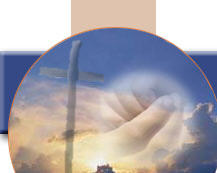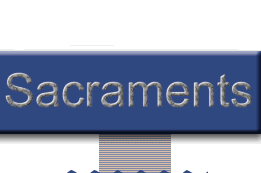



|
|
Overview |
|

![]()
The Language of Sacramental Life.
"Symbols give rise to thought"
Paul Ricoeur.
I look down at a baby cradled in my arms and I feel warm and loving towards this small child. I smile at him. And he smiles back at me.
The baby has seen my smile; he interprets it and responds. I get a great thrill because for the first time he has recognised and responded to me. I know it is not just wind! We are in the world of symbol. We are in the world of love. We are ‘speaking’, communicating, through a symbol. The symbol indicates that I am happy to be with you, to be holding you, to be held by you, I have confidence in you, I find joy in you, in you I am content. It says so many things; it is inexhaustible in its meanings.
In that relationship with the baby I am in a realm beyond rational thought and I "know" the communication between us speaks more powerfully than rational thought. I know because I cannot really rationally explain it to another. I am caught up in a depth of powerful and life giving meaning
It is like when I go to the funeral of the parent of a friend of mine. I want to approach my friend, but what do I say? I am caught in a need for which rational words are inadequate, so I go up to my friend and look into her eyes, sharing her grief and all I can do is just hug her and hold her for a moment. "All I can do", "just" - we tend to be-little such actions, to see them as inferior to the spoken, rational approach. Yet in this moment with my friend I have communicated in ways that are more powerful and more comforting than spoken words.
Symbols function like metaphors. We learnt about metaphors at school in English class! They begin from a first meaning of something, e.g. the warmth of fire, and refer this first meaning to second meanings. So I can talk the warmth of friendship. I learnt in that English class that this poetic movement from one meaning to a second meaning is called analogy.
By living in and staying with "first meanings" of something I can be drawn beyond that meaning. The first meaning of fire, for example, is found by living with fire. Fire warms us, it burns rubbish, it is bright, it is forever moving, it is fascinating.
Once we have lived with something in its first meanings then it can become symbolic for us. If we don't live with something then it cannot work for us. To say "I'm as cold as ice" to a Bushman of the Kalahari desert would not communicate anything! However, having lived with fire, I can say to the same Bushman, "Our friendship warms me".
Referring to God using the symbol of fire I can speak of God
· as a purifying fire - God gets rid of the rubbish of my life.
· as the warmth of the Divine Love,
· as "lighting up my life",
and so on.
Another thing about symbols is that the same symbol has two opposite meanings. Symbols integrate opposites. Fire warms, but it also burns. Water refreshes, but it also drowns. I can touch someone with love or hit them in anger.
So, in Christian ritual symbols can signify death AND resurrection, positive and negative forces, and the need for reconciliation between such forces.
The water of baptism starts me on a journey where I am called:
- to be dead, drowned, to inappropriate ways of life; to be part of the death of Jesus.
- to be alive, to appropriate ways of life found in the community of Jesus; to be part of the resurrection of Jesus.
We "know" this symbolic presence of God in the shape of sacramental rites. This shape speaks of the role of the Word and the role of the Spirit.
In baptism, for example, God's WORD is used to give this water a certain context. We can read of the Water of the Flood, the Water flowing with the blood from Jesus' side on the Cross, and we can recall Jesus' own baptism. Yet as St. Basil says: ‘if there is any grace in the water, it is not of the nature of the water, but of the presence of the Holy Spirit’. The SPIRIT moves us to be open to what this water symbolises. There is a dynamism between WORD and SPIRIT that makes this Word and Symbol a powerful moment in appreciating God's presence breaking in to our lives.
Let us open out this symbol more. Water in its first, primary, meaning cleanses us, it refreshes us, it gives life, it floods, it drowns, it washes away. The breaking of waters precedes the birth of a child. Used with the Word of God in the Ritual of Sacraments we could speak of this water being the symbolic Presence of a God whose water breaks over us and we are reborn in Christ in ‘Mother Church’. In Baptism we are called to be drowned to sin - it is a symbol of the death of Jesus. But Baptism also refreshes us, gives us life - it is a symbol of resurrection.
So it is with the symbol of Oil. Oil as a lubricant gets things moving; as an ointment, it heals; as a fire, it warms and destroys; as a lamp, it enlightens our darkness; as a liniment, it strengthens; as a cosmetic cream, it enhances and beautifies; as a moisturiser it soothes; as 15+ in summer it protects. These are its first meanings
Used in ritual, oil makes present to us, symbolically, the God who protects, strengthens, heals, soothes, enhances, beautifies, purifies, warms and enlightens us.
Hence
- in the Sacrament of Confirmation I am strengthened, enlightened to use my gifts well. In the Spirit my baptismal commitment is enhanced.
- in Anointing of the Sick I am healed of distress and even physical ‘dis-ease’. The destructiveness of sickness, and even death, gives way to hope and strength in a protective, enlightening God.
A good exercise would be to think of the primary, first meanings of other symbols used and think of how they apply to the second meanings of religious ritual. What do you associate with the symbols Bread, Wine, Touch? E.g. ‘touch’ has embrace as one primary meaning. What are the second meanings when we use touch as a symbol?
One of the things to note is that the best symbols are universal. When we use fire, water, earth, oil, the sun, smoke, tree, wind, breath, touch we are using things that are common to all peoples, all human experience.
Many countries in our world are now made up of multicultural societies so to use such symbols is helpful. They can unite people, where-as rational thought expressed in one language can exclude some. Universal symbolic language is inclusive of all people, whatever age (even small children) or culture or language.
To sum up, as Paul Ricoeur's says ‘Symbols give rise to thought’, and this is the impetus for all our thinking and reflection about sacramentality:
- symbols are the ‘language’ of sacramental life;
- symbols point from themselves to something else;
- symbols always point from a first meaning to a second meaning - the first meaning of a symbol leads by ANALOGY to a second meaning;
- it is by living in the first meaning that we are drawn beyond it;
- the most powerful symbols are universal;
- symbols integrate opposites; dark/light, good/evil, life/death;
- symbols open up a level of reality for which non-symbol speaking, including rational thought alone, is inadequate;
- a person can participate in a symbol without understanding it;
- symbols are the language that speak to the human person's spirit of the sacred;
- symbols do not "explain" things, they open up meaning.
- in Catholic thought, symbols express the Real Presence of God.
We now use these thoughts about symbolism to speak of Jesus, the Church and the seven Sacraments.
Further Reading
Cooke, Bernard. "The Distancing of God: The Ambiguity of symbol in History and Theology."
Fortress Press, Minneapolis 1990.
A Challenging study of the relevance of symbols of God’s presence.
Power, David. "Unsearchable Riches: The Symbolic Nature of Liturgy."
Pueblo, New York 1984.
Power makes reference to Paul Ricoeur whose work is the basis for this section of the book.
|
|
|


Copyright © Anthony Kain 2009